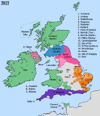| |||||||
| Capital | Matlock | ||||||
| Largest city | Matlock | ||||||
| Other cities | Darley Dale, Rowsley | ||||||
| Language | English | ||||||
| Religion | De facto Christianity | ||||||
| Demonym | Matlocker | ||||||
| Government | Autocracy | ||||||
| Legislature | Advisory Council | ||||||
| Population | ~9,000 permanent | ||||||
| Established | 1988 | ||||||
Matlock is a confederation of towns in former Derbyshire, United Kingdom. Lying (for the most part) on an 8.8 mile stretch of the east banks of the River Derwent, it is surrounded by a wall 8.9 miles (14.5km) long on its eastern border. After Doomsday Matlock became a market town, but under pre-Doomsday entrepreneur Steve Saxon it grew to become a haven for drugs growth, gambling, prostitution, and mercenary activity. Despite having almost nothing in the way of agriculture or industry the confederation remains comfortable from the profits from its activities and intimidation of local farming communities.
History
Pre-Doomsday
A former spa town, Matlock lay on the River Derwent, and has prospered from both the hydrotherapy industry (a post-Doomsday selling point) and the mills constructed on the river and it tributary Bentley Brook. It was an unimportant collection of small villages — Matlock Town, Matlock Green, Matlock Bridge, Matlock Bank — until thermal springs were discovered in 1698. The population increased rapidly in the 1800s, largely due to hugely popular hydros being built. At one stage there were around twenty hydros, most on Matlock Bank. The largest was built in 1853 by John Smedley. This closed in 1954, and re-opened in 1955 as the headquarters of the Derbyshire County Council.
Doomsday
Matlock and its neighbours were not directly affected by Doomsday; no nuclear weapons were detonated in the immediate vicinity. However, Chesterfield (ten miles to the northwest) was half-destroyed when a malfunctioning warhead detonated slightly too early, and was later consumed by a firestorm; furthermore, several devices were detonated twenty or more miles distant - the cities of Derby, Sheffield, Nottingham, and numerous others over Greater Manchester. With no clear governance the police rapidly took charge, putting the area under martial law. Around midmorning refugees fleeing from the damaged cities began to pass nearby, with some residents choosing to join them. Most, however, chose to stay indoors as per the instructions from the intermittent emergency broadcasts.
In the weeks and months following Doomsday, Matlock began to feel its effects. Rainout and fallout affected local crop and animal growth, leading to a number of starvation cases. The Derwent was not directly contaminated by radiation, but human and animal corpses decaying in and near its banks upstream meant that it was a risky source of fresh water. The winter was slightly more cold than usual, causing yet more crop damage and starvation, and the following extra-warm summer meant that harvests failed. The population of Matlock and the surrounding towns fell to less than six thousand as many of the survivors left to seek new land.
1984-1987: Struggles
A ray of hope came to people's lives as they entered the new year. Steve Saxon, a pre-Doomsday businessman from Sheffield, his family, and a small armed entourage arrived in the area in February. Upon meeting the town council he was disgusted at how slow and ineffective it was; it had barely instituted any policies into cleaning the houses of the dead or food rationing. As he settled his family in he encouraged his new neighbours to institute policies that he had observed in other communities he had been passing, such as putting all available land to crop growth and numerous other improvised techniques that had emerged amongst Doomsday survivors. This soon earned him a popularity base, and by mid-1984 he was openly challenging the council over issues. In August, in the midst of the baking nuclear summer, he and those loyal to him forcefully dissolved the council meeting and installed himself as sole leader of Matlock, with handpicked advisors. Few were bitter over the changeover; Saxon's supporters had already volunteered for numerous different tasks, such as care of the sick, removal and burial of the dead, and maximising arable land.
However, the following months were still difficult. Starvation cases continued throughout the winter and into 1985. Worse, organised gangs of raiders were starting to form, prowling the countryside for whatever food was available. Matlock suffered three separate incursions between January and April 1985, losing over a hundred lives in the process. Saxon ordered the establishment of a brigade of volunteer defenders, but their numbers (just two hundred) and insufficient, improvised weapons meant they dealt almost no casualties to their opponents, although they were briefly scared off.
Taking advantage of this reprieve Saxon looked to the months again. Another failed harvest was likely, especially on the understaffed farms in the area. Calling a meeting with the leaders of other nearby towns Saxon proposed a scheme to volunteer - and impress, if necessary - enough able-bodied men and women to fully staff the local farms. There was resistance both from the new farmhands and the original farmers, who feared (rightly) that it was a ploy by the towns to force the farmers to share their scant produce. However the appearance of the newly-christened 'Matlock Matchlocks' was always enough to convince the farms to admit their new workers; verbal and even physical abuse remained an issue, however.
That summer there was just enough food to feed the entire valley, although it meant intensive rationing - in many cases, a single piece of bread every other day. However, the population scraped through, and as the nuclear summer's intense heat trailed away into more bearable temperatures the population was happy to praise Saxon for his efforts. That autumn he drew even further acclaim by leading hunting parties out into the increasingly wild countryside, hunting feral flocks of sheep. Allegedly, he even found a wine cellar and returned its contents back to the valley (though various sources state that Saxon was not on the particular scavenging mission that located the cellar).
As 1986 drew closer raids grew again more frequent. One such case saw the attackers attack a makeshift granary in Darley Dale, seizing much of its supplies, and dumping the bodies of those they killed into the Derwent, partially contaminating it. In 1987 the attacks only worsened after a particularly large clan took up residence in the ruins of Riber Castle, proceeding to launch almost nightly incursions into Matlock throughout the entire spring. After a costly battle to drive them out, they merely seized a manor house near Rowsley and resumed the attrition. In July Saxon, who now possessed hegemony over the entire valley in all but name, decided that enough was enough. Hiring mercenary gangs from across the countryside a combined force of over six hundred men attacked the manor in a brutal hand-to-hand slaughter. It was a success, and soon not only had the attacks ceased, the mercenary gangs had found they could make a better living directly serving Matlock rather than attacking it and nearby villages; a relative peace was established in the area. The entire string of good fortune was placed, by a populace with otherwise nothing else to believe in, on Steve Saxon. With a devoted workforce Saxon's powers were nearly unlimited. After 1987 brought the first truly successful harvest, he could suggest such ideas as establishing a market where the local villages and farms could trade their produce. This soon led to opportunistic locals who were otherwise unemployed being able to put what skills they had to good use. A few small workshops were established, but more entrepreneurial individuals found that there was more that could be done. Several churches reopened, charging potential attendees for their use. Those who had scavenged or stashed alcohol could resell it at fantastic prices. The slowly-amassing surplus of wealth allowed gambling and prostitution to be considered; several hotels were soon adapted to serve as joint brothels and casinos.
1988-1993: Word spreads
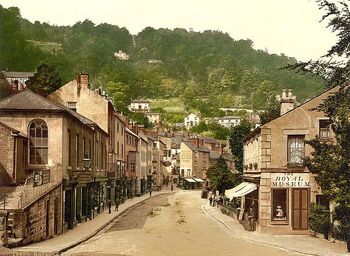
A rare post-Doomsday, pre-2000 photo of Matlock.
By 1988 the people of the valley were at a stage where they could safely expect a meal every day, sometimes two. Starvation had been mostly prevented, save for amongst the very young and the very old, and illness and death soon overcame those who could not contribute to society. In March there were calls (allegedly planted by Saxon's supporters) to transform the towns into a confederation organisation to better share resources and tools. Unsurprisingly, it was suggested that Steve Saxon be the leader of this confederation, and that it be headed from Matlock. On May 22nd the new state came into fruition, named simply 'Matlock', with Saxon's official title becoming 'First Representative', a name taken from his governing body of representatives, all of whom were close allies of Saxon. The first move of this new confederacy would be to construct a single, nine-mile wall surrounding the area to dissuade future raider assaults.
The prudency of this move was questioned by some, in spite of unwavering support for Saxon. Did they really need a wall when there were still farms that could be improved upon, or raiders driven away? Could the state even afford the manpower? Saxon merely dispelled such concerns with cryptic remarks about the state's future. The first question was never answered - but the latter was, and from a most unexpected quarter. Visitors leaving the towns were asked to inform those they knew of 'the Great Matlock Project' - an invitation to perform work in return for good pay and access to the confederation's already-infamous amenities. Matlock Matchlocks were also dispatched to drum up support. To the surprise of many, nearly a thousand volunteered from as far afield as the scavengers in the outskirts of Greater Manchester and Sheffield. These workers arrived, expecting easy work for easy money.
These labourers, mainly men, were wrong. Construction of the nine-mile long, 1.5-metre-wide, 3-metre-tall wall would be difficult and even literally backbreaking labour. The wall was to be constructed using the rammed earth method, which was intensely difficult without electric earth-ramming machines. Furthermore, these labourers barely received the recompense they expected - food was for Matlockers first, labourers second. All that kept the workers going was the promise of the post-payday indulgence of frequenting brothels and getting drunk - something which involved locally-brewed, and dangerously alcoholic substances.
The construction of the wall took two long, difficult years. In 1989 the sub-par harvest led to a string of starvations amongst the workers and the citizenry. Over the winters work had to stop entirely lest the compressed earth get wet, slowing the speed of work, and in summers only those that could face the scorching heat were able to continue work - and at least seventy of them died from heat stroke. But by 1990 the wall in its entirety was complete, connected to the restored Riber Castle. In its wake came a horde of now-useless labourers. Despite the two years of mistreatment they had been forced to endure, many of these immigrants were slow to return home. Bonds of comradeship had been created during the wall's construction, which some were reluctant to break up. Some simply did not have - or did not know if they had - a home and family to return to. Lured by the promises of proper treatment and settlement grants, many workers opted not to return to their communities and instead settled in the valley, often inviting their families to join. Roughly three hundred workers, plus four hundred of their friends and family, decided to take up residence within Matlock.
By this point word of the state had spread far and wide. People would make journeys of up to fifty miles to visit the state, which rumour had built up to be a veritable Las Vegas of post-Doomsday Britain. Most were not underwhelmed; the towering walls, abundance of food and loose morals ensured that many a customer was satisfied, and indeed opted to take up permanent residence in the town. Nomadic clans from across central England came to trade and enjoy themselves, risking their own lives at the growing numbers of cutthroats who stalked the increasingly busy routes to the walled state just for a few days of fun and trade. Many of those who realised they were suffering from cancers would often opt to spend their final days in the city before committing suicide; tragically, out of concern for quarantine, those who were suffering from virulent and deadly diseases would often be turned away at Matlock's gates. Yet despite such tragedies, the rampant crime in the area, and the fairly low standard of living compared to the more organised states that were developing elsewhere in the UK, life in Matlock was a veritable Cloud Nine for the average Doomsday survivor.
1994-2000: Twisting fortunes
The mid-to-late nineties was a turbulent time for the Matlockers. The era began with the establishment of electricity, with a water mill constructed along the Derwent. Although its output was low, it was enough to power a single searchlight which had been scavenged from the countryside and was used as a beacon to lure visitors to Matlock. As more mills were established, there was soon enough to light up much of the valley at night; purchases of coal from Alfreton soon allowed the richer brothel-bars to function late into the night. Like many parts of the economy, Saxon soon found a way to profit from the coal trade, by reselling excess stocks at massively inflated prices to visitors.
However, Steve Saxon was soon starting to show signs of strain. He was growing increasingly paranoid about the representatives in his advisory council. In spring 1995 one clan that entered the state took advantage of its unsuspecting locals to steal from several establishments and kidnap several prostitutes before escaping. Saxon would subsequently order his entire defense force to seek out and destroy the clan, leaving Matlock wide open to a raider assault that managed to sneak in via Biggs Hill and attack Rowsley. He would subsequently order the execution of three of his closest representatives, suspecting them of having let the attacks happen. He would also order the construction of a vast pyramid and have his head carved into the Heights of Abraham which overlooked Matlock Baths. A psychologist was quick to diagnose Saxon as exhibiting megalomania.
The representatives were unsure of what to do. To kill Saxon would be both immoral (not that morals were particularly applicable in Matlock) and emotionally stressful; to ask him to step down would certainly incur Saxon's wrath; and to stage a coup, though feasible, would still leave difficulties over what to do with Saxon. Throughout 1996 Saxon would demand a newer, grander and more unfeasible plan nearly every week, ranging from creating a sixty-foot golden tower of his person to uniting the visiting tribes to create a crusade to reconquer Britain. He took to dressing ridiculously extravagantly, paying pickpockets to steal gold from traders to adorn his many robes. Though a few of his projects were feasible, and took place - such as redoubling the strength of the defensive walls by adding to their height with rock and digging a defensive ditch - his behaviour soon obstructed them. As work on the upgraded wall began (again using volunteer labour, though this time somewhat better-treated and better-equipped), Saxon developed Obsessive Compulsive Disorder, lashing out at workers who failed to place rocks in particular patterns. It was in doing this he met his demise, by assaulting a Romany man for refusing to place rocks in the wall in his desired pattern. The man, who had been picked on constantly for weeks by Saxon, took the First Representative down with a single hit to the stomach - a hit hard enough to cause heavy internal bleeding. Steve Saxon consequently died a week later, on April 11th, and was buried in front of the Darley Dale war memorial.
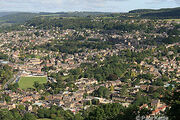
Matlock, as seen from Riber Castle
In his place came Saxon's son, David Saxon. The younger Saxon had been interested in his father's business tactics since before Doomsday, and now aged thirty-five was bursting to put his ideas into action. His favourite of these was the production and selling of narcotics. He spent over a year waiting for his scouts to locate a source of hemp and opium poppies, which was eventually scavenged from Sheffield (having grown wild outside a drug den). In the meantime he tried to further the variety of amenities within Matlock. Early 1997 saw the opening of a wrestling stadium, which within a decade would evolve to neo-gladiatorial combat and would be a massive crowd-pleaser. Musicians were taken on as minstrels and buskers. David Saxon also made certain to place large taxes on independent businesses; though the move was initially unpopular, Saxon the Younger wished to see the economic security of the state, which could be ensured by propping up new businesses and using the taxes to feed Matlock residents. By this point, the towns had a collective population of 8,000, and could see as many as four or five thousand others lodging there at any one time.
A point of note for 1998 was the state's brief entertaining of a division of the True British Army. Seven hundred men on a long range exploratory mission briefly adopted the state as their base of operations. During their ninth-month stay they soon came to be quite strongly appreciated by the locals; separation from the TBA's territory enforced a sense of humility and respect upon the exploratory troops, and despite a few cases of assault and theft the division was generally well-behaved. Indeed it proved critical when a large clan of raiders attempted to conquer Matlock in a three-week siege, the TBA men helping the Matlock Matchlocks fight off repeated attacks. The division eventually departed back to its home territories when it was decided that the TBA did not need long-distance outposts. In late August an estimated four hundred TBA troops returned to Matlock following their defeat by the Organisation of British Nations.
By 2000 David Saxon's scheme of drug production was well underway, and by July the first batches of cannabis and opium were being sold in Matlock's markets, unsurprisingly drawing massive profit. Along with the reopening of the hydros in Matlock Bank based around the thermal springs, Matlock's entertainment industry was burgeoning.
2001-2004: Downturn
The start of the new millennium was viewed with optimism, but in fact several tragedies were imminent. The first of these occurred early in 2001. Carried in by a visitor was a vastly stronger version of the common cold. This disease soon spread like wildfire within the walled city. Its symptoms were not dissimilar to the flu; those struck down would begin to sneeze and suffer from a headache and a sore throat. Several days in, however, they would then develop a fever and begin to vomit heavily; the more malnourished were particularly at risk from the latter symptom. Initially the disease was put up with; many survivor communities had endured far worse than an outbreak of the common cold. But soon the harsher latter stages of the disease flared up en masse, striking deep concern into both the locals and the visitors. After all, these resembled the conditions of radiation sickness (as far as could be diagnosed by the locals) - they feared that, somehow, the area had become contaminated. Nevertheless, business continued as usual, until May, when a group of concerned travelers decided to camp outside the city until the plague was over. This image struck fear into other newcomers, and soon many people were either camping outside Matlock or turned around all together. The slump in trade greatly affected local businesses and the lack of incoming food subsequently damaged the overall ability of the population to fight the disease. Large parts of Matlock were quarantined; a small corps of volunteers had to be formed to deal with those too weak to move, or the dying. By June conditions were so bad that it was estimated that on average one person died every two hours. This peaked in the third week, with some two hundred dying.
Thankfully deaths rapidly declined afterwards; by August the disease had cleared entirely and business slowly resumed, returning to usual levels by October. But the plague had left its mark - five hundred had died, three hundred of whom were Matlockian natives, and some 30% of the population had been heavily afflicted. Only 10% had gone without any symptoms whatsoever.
2002 was mostly without incident, but saw an attempted raid on the state's drug farms by armed bandits in July. The plague briefly resurfaced in November, but only seven died over the six weeks it was prevalent.
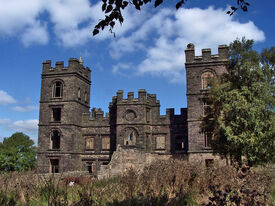
An image of Riber Castle prior to its renovation into the keystone of Matlock's current defences.
In 2003 the unusually warm summer resulted in a disastrous fire which caused heavy damage to Darley Dale. Thirty people died and over seventy buildings were burned to the ground, with a hundred and fifty others damaged. Once again the city's business suffered a hit, though again managed to recover, and by rallying the community through calling upon his father's charisma David Saxon managed to ensure the damage was mostly repaired by September. Several sites that were totally destroyed were cleared to make way for a small neighbourhood garden.
The bane of the following year was a massive spike in raids from the south. A conglomerate of nomadic clans was briefly united by the prospect of conquering Matlock for their own benefit, and numbering over six hundred unleashed constant attacks throughout the year. The Matlock Matchlocks tried and failed many times to drive the nomads out, but they always managed to evade detection and then returned. Seventy-six people were killed by the nomads, the majority Matchlocks. However, they were finally and conclusively driven out after their eighteenth raid on Riber Castle, when they attempted to set the interior alight and then scale the walls. The local commander decided to allow the nomads to establish a foothold but forced them into a violent close-quarters battle whilst more nomads attacked. The attackers were then surrounded by a half-pincer from the northeast and crushed, killing or wounding over two hundred and finally proving to the remaining nomads that their war was unwinnable.
2005-2010: Stability
In recent years Matlock has not faced any majors challenges, allowing its economy to expand by leaps and bounds. In this period it was visited by several northern nations - the Celtic Alliance in 2005, and the Duchy of Lancaster and Kingdom of Cleveland in 2007. All three looked disdainfully on the moral laxity of the state though noted with interest the relative uniqueness of the state's structure, at least in northern England.
In October 2008 a number of TBA survivors and the second-in-command of the original mission to Matlock returned to the city-state, asking for asylum. They soon integrated into the Matchlocks and through sharing knowledge and limited weaponry the overall effectiveness of the force increased somewhat. In 2009 a bad harvest forced it to look further afield for food supplies, but managed to establish a trade deal with a large commune of farms eastward of mutual ally Alfreton. This, combined with careful managing of rationing and intervening with the pay levels of numerous businesses, managed to prevent the starvation of any Matlockians.
In April 2010 it was discovered that a Scottish spy ring had a base in Matlock, rumoured to be a base for infiltrating into nearby nations; the government of the fascist state flatly denied the charges.
2010-To Present: Expansion
Due to the increased stability in the last few years the control the government of Matlock has on the surrounding countryside has expanded outwards to take in the surrounding towns of Alfreton (which Matlock already had trade agreements with), Bakewell, Belper, Newhaven and Ashbourne.
They have also made trade agreements with the local independant trade town of Mansfield and the spring water town of Buxton.
Matlock has also has trade agreements with the Newolland towns of Worksop and Retford. They have also sent a delegation across the Peak District to the Celtic Alliance town of Macclesfield.
Society
Structure
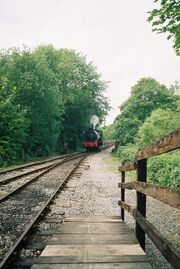
In recent years the railway in the area was restored with a handful of steam engines run on Alfreton coal. This rail line offers the chance for Matlockers to commute and visitors the chance to explore the city-state further.
Matlock is an autocratic (though some would say oligarchic) state. At its head is the First Representative. This title is universally recognised as a formality to give the government an air of legitimacy, and it is far more common for citizens to refer to the First Representative as 'the Boss', 'the chief', or similar. It is currently held by David Saxon, eldest son of Steve Saxon who established Matlock. It is expected that the position will probably be held in the family and taken over by either David Saxon's wife, brother or daughter, though his close friends hold hopes that they might be named his successor. In the elder Saxon's reign the representatives on the Advisory Council were handpicked for loyalty, but the younger Saxon chose to add introduce an element of democracy by having half the Council selected via lottery. These temporary councillors, however, are themselves only put up for the lottery if they are known to be loyal, and not troublemakers.
Below the Advisory Council is the thin wafer of the population that controls the majority of amenities in the state. These men and women make massive profits from their administration of casinos, bars, brothels, and shops. In September 1997 Saxon placed large taxes on the earnings of these people, which were then used to support the welfare of the working class.
The workers make up the majority of the population - some 80% thereof. Roughly a third work in directly nationalised works, such as in the military, infrastructure upkeep, or the drugs industry. The rest are employed, and those who are out of a job still manage to find something to sell - goods, room in their houses, or sex.
Geography
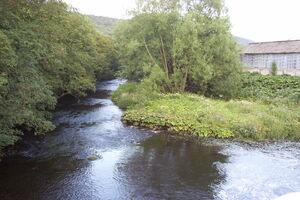
The River Derwent at Rowsley, the northernmost part of Matlock. It is being joined by the River Wye.
Matlock lies on the east bank of the River Derwent as it flows through Derbyshire. It is enclosed by a large stone wall which was built to repel raiders, though having been without a major attack for years this wall now is as much about delivering an imposing image as it is for defense. This wall is built along high ground wherever possible; the valley is so steep that there is over a hundred metres difference between its highest and lowest points. The wall connects to the restored Riber Castle which overlooks the south side of the town of Matlock.
The Matlock Confederation is composed of several towns and villages. From north to south:
- Rowsley
- Darley Dale
- Hackney
- Matlock
- Starkholmes
- Matlock Bath
Matlock Bath, originally, was not a part of the confederation, as it lay on the west bank of the river. However, it acted as a useful gateway, was easily defensible, and was decently equipped, so in 1992 it was also admitted after constructing a rammed-earth wall on its western and southern border (its northern being almost impassable, as it was the heavily forested side of the Heights of Abraham).
Foreign relations
Matlock's relationships with other nearby powers varies. It has numerous opponents, but Matlock lacks the army to deal with them, and its opponents generally lack the motive to attack. It also has numerous friendly city-states; Alfreton, ten miles to the southeast, is a fairly close ally of Matlock and provides the confederation with coal. Matlock generally puts this coal to its own use or resells it to visitors at massive prices. Its novelty and unique trade opportunities mean that nomadic clans and tribes generally try to avoid behaviour that would see them banned from the walled state.
It has been encountered by expeditions from the Celtic Alliance, Duchy of Lancaster and the Kingdom of Cleveland, all of whom made note of the state's considerable moral decay. The state briefly entertained a detachment of troops from the True British Army in the mid-90s, but the garrison left when it was decided the state was far too remote to be a useful command centre.
| ||||||||||||||||||||||
| ||||||||||||||||||||||



